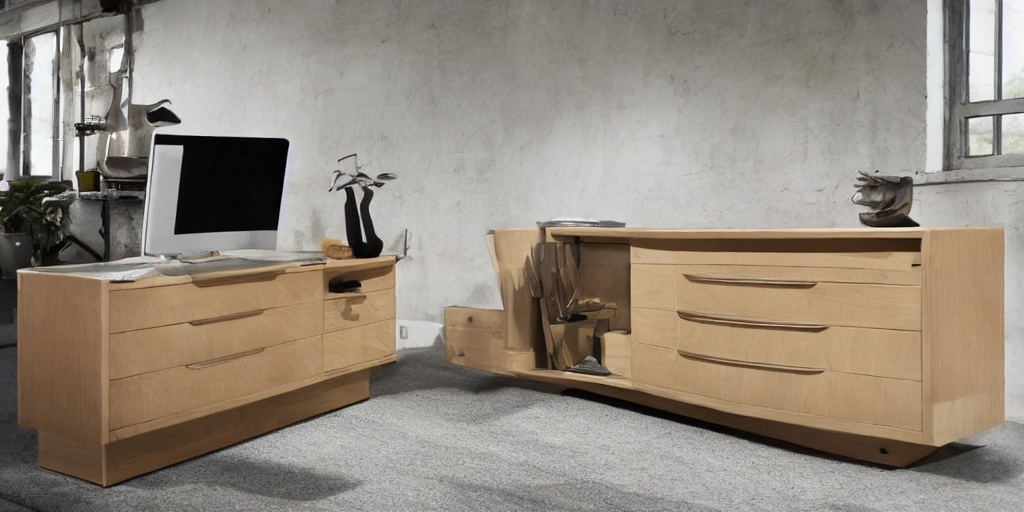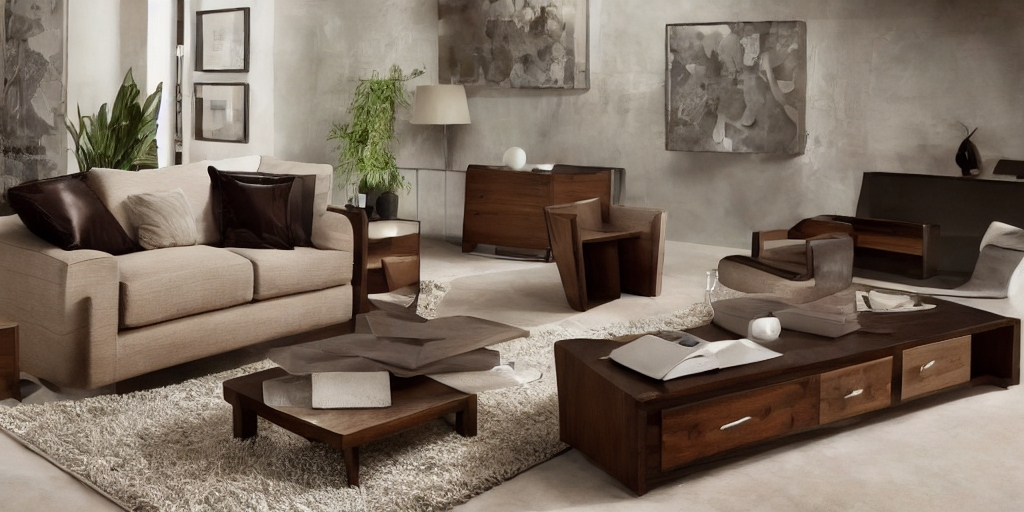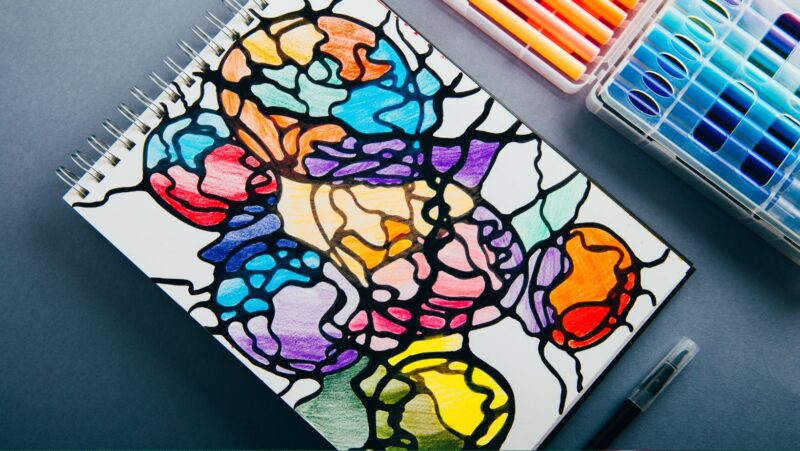Furniture isn’t just about comfort—it’s a form of art, a reflection of personal style, and a key element in shaping the aesthetics of a space. Furniture design, therefore, holds a significant place in the realm of interior design, architecture, and even art.
In the world of furniture design, creativity meets functionality. Designers play with forms, materials, and colors to create pieces that are not only visually appealing but also serve their intended purpose effectively. This article delves into the fascinating world of furniture design, exploring its history, evolution, and the innovative trends shaping its future.
So, whether you’re a design enthusiast, an aspiring furniture designer, or simply someone who appreciates the beauty of well-crafted furniture, this exploration will offer a wealth of insights into this dynamic field.
The Role of Furniture Design in Contemporary Interiors
Furniture design plays a pivotal role in shaping contemporary interiors. It brings a spatial concept to life, embodies aesthetics with utilitarianism. Furniture, when thoughtfully designed, enhances the functionality of a space without jeopardizing its visual appeal.
In modern interiors, designers strive for a balance between form and function. They build upon the principles of ergonomics, creating furniture that suits the human body’s needs and the room’s size constraints. Examples of this can be seen in adjustable tables, ergonomic chairs, and multifunctional furniture pieces that work on space-saving principles.
Materials and colors greatly influence, too, the interior aesthetics. The choice of material, such as wood, metal, or fabric, influences both the look and the feel of the furniture. Designers often select materials based on their properties, such as durability and ease of maintenance. Colors play a psychological role in shaping perceptions and emotions. The color of furniture can create harmony or contrast, emitting tranquility or energy.

Furniture design contributes to the overall theme of an interior. Whether it’s minimalist, vintage, or rustic, furniture helps establish the theme and reinforces it throughout the space. Notably, Scandinavian designs, characterized by simplicity and functionality, have sparked global interest. They’re noted for their clean lines and natural aspect, illustrating how furniture can set the scene for a particular interior design style.
In contemporary interiors, furniture also plays a crucial role in defining zones. By rearranging furniture, people can create subtle partitions in an open space, offering both privacy and openness. Modular furniture, space-saving units that can be reconfigured, demonstrates this functionality.
Lastly, innovation in furniture design is drastically influencing contemporary interiors. Technology-infused furniture, such as beds with built-in speakers or tables with wireless charging points, is emerging. This illustrates the integration of technology into everyday items, enhancing comfort while matching the pace of the digital age, and thusly, shifting the landscape of furniture design.
In a nutshell, furniture design, with all its facets, intricately influences contemporary interiors, dictating functionality, aesthetics, space distribution, and more. This influence is only expected to grow with the progression of design trends and the integration of technology.
Key Elements of Furniture Design
Building upon the concept of furniture design’s crucial role in shaping contemporary interiors, one must pay attention to its key elements. These elements contribute to the crucial balance between aesthetics and functionality, guiding the designer through the design process.
- Form: The form of a piece of furniture is its shape or outline. It is one of the key elements that influence the aesthetic appeal. Furniture with sleek lines and minimalist design, for example, suits contemporary spaces, while chunkier, ornate pieces often reflect a more traditional setting.
- Ergonomics: This ensures the furniture design prioritizes human well-being and enhances productivity. A chair with a well-designed backrest and seat, for example, provides essential support to the spine and hips, promoting better posture.
- Material Selection: The choice of materials significantly influences the visual aesthetics and the longevity. Traditional wood, practical plastic, or modern metal, all contribute different benefits. Furniture made of reclaimed wood, for instance, offers an eco-friendly characteristic to the design.
- Color scheme: A well-coordinated color scheme complements the overall interior design vision. Monochrome furniture enhances minimalistic interiors while colorful pieces generate an eclectic vibe.
- Craftsmanship: Superior craftsmanship increases the intrinsic worth and durability of the design. For example, joinery techniques used in handcrafted wooden furniture often indicate its quality.
- Space Utilization: Good furniture design optimizes space efficiently. This can be seen in designs like multi-functional furniture, such as sofa-cum-beds, which serve dual purposes without occupying additional space.
- Trend Alignment: Furniture reflects prevailing design trends, such as the currently popular mid-century modern style, adding a sense of time-relevance to spaces.
Knowing these key elements and implementing them strategically helps designers create inspirational pieces that maintain the tricky equilibrium between form and function while suitably aligning with current trends. The balance of these elements results in a fusion of aesthetics and functionality that pushes the boundaries of what furniture design can achieve in modern interiors.
Influence of Historical Periods on Furniture Design
Historical periods, with their unique cultural and aesthetic qualities, cast a significant impact on the evolution of furniture design. Designers draw inspiration from these eras, transfusing their iconic elements into modern pieces. They blend historical aesthetics with contemporary functionality, resulting in an enchanting fusion of old and new.
The Classic Influence
Firstly, the classical periods, comprising the Greek, Roman, and Renaissance eras, have shaped furniture design profoundly. Greek furniture design, known for its straight lines and geometric shapes, introduced concepts like proportion and symmetry into design philosophy, seen in the geometric designs of many modern pieces. The Romans, often blending function and aesthetics, brought innovations like triclinium – the first dining room furniture. During the Renaissance, artists like Leonardo da Vinci and Michelangelo revolutionized furniture design, bringing a humanistic approach to ergonomics and form.
The Oriental Effect
Secondly, the influence of Oriental design cannot be overlooked. Chinese and Japanese furniture designs, with their minimalist appeal and superior craftsmanship, have significantly impacted modern interior design trends. Appreciation of nature in Japanese design has influenced the use of organic materials and fluid forms. Chinese design, with its intricate patterns and bold color schemes, has equally inspired current trends.
The Modern Surprise
Lastly, the Industrial Revolution ushered in a new era for furniture design. Introducing elements like metalwork and mass production, this period transformed furniture dynamics with its aesthetic of simplicity and utility. This inspiration is evident in today’s design movement, “Modernism,” characterized by clean lines, uncluttered aesthetics, and a focus on function before form.
Furniture design, thus, is not a stand-alone entity, but a continuum, drawing depth and richness from historical periods. Every period, possessing its unique identity and ethos, contributes to this ongoing narrative. It offers an understanding of how form, material selection, color schemes, craftsmanship, and space utilization have translated into the aesthetics prevalent in today’s design scenario. History influences not just how furniture looks, but how it is used and the ambiance it creates in a space, an influence that is likely to continue shaping future trends.
Understanding Furniture Design Styles
Digging deeper into the realm of furniture design, one uncovers an array of styles. Historical periods have nurtured these styles, promoting uniqueness and diversity. As a result, iconic forms have emerged in space decoration.
Firstly, there’s the Minimalist style, radiating simplicity and functionality. It focuses on basic elements and hues of black, white, and gray, thus eliminating clutter and embracing clean lines. Minimalist-inspired furniture such as white-painted metal chairs or glass-top tables breathe minimalism into spaces.
Next comes the Scandinavian style, a marriage of comfort, simplicity, and functionality. Scandinavian furniture centers around clean lines, robust wooden materials, and muted, earthy colors. Examples include light wooden bookshelves or sofas accented with cozy, knitted throws.
Following this is the Mid-Century Modern style, prized for its retro, timeless appeal. Born mid-20th Century, it converges functionality and organic shapes, using new materials such as plastic. Examples include Eames chairs and Noguchi coffee tables.
Furthermore, there’s the Industrial style, a robust blend of raw textures and unfinished spaces. Promoting an unkempt aesthetic, it incorporates materials like metal, brick, and rough-hewn wood. Objects like metal bar stools or weathered leather sofas embody this style.
Lastly, the Traditional style, exuding refinement and consistency, showcases rich wood treatments, elaborate moldings, and ornate detailing. Examples include mahogany dining sets or plush, button-tufted sofas.
Each style carries its ways of enhancing the coherence and aesthetics of interiors, catering to diverse preferences. An understanding of these styles aids in making informed decisions, tailoring the perfect ambience for any space.
Future Trends in Furniture Design
Diving forward, observers notice evident transformational trends set to redefine the landscape of furniture design in upcoming years. These trends combine the lessons of the past and the possibilities of the future, curating an enticing blend for the aesthetics and usage of modern furnishings.
Sustainable design emerges as a dominant player in the field. Driven by environmental consciousness and eco-friendly practices, designers increasingly opt for sustainable materials such as reclaimed wood, bamboo, or recycled metal. Likewise, the production processes also gain a green slant, emphasizing energy efficiency, minimal waste, and low chemical emissions. Brands like Emeco or Sawkille Co. exemplify this trend, demonstrating the potential of sustainable design in modern furnishings.
Smart furniture also stakes its claim in the future trends. Its emergence lies within the intersection of furniture design and advancing technology. Futuristic pieces now entail wireless charging capabilities, integrated bluetooth speakers or even health-monitoring functions. Brands such as IKEA or Herman Miller bring forward designs with embedded smart technologies, merging comfort, functionality, and innovation.

In the same vein, minimalist design continues to stay relevant. With clean lines, uncluttered spaces, and a preference for essentiality over excess, it’s the trend that ties well into the compact living movement. Smaller living spaces demand clever, multi-purpose furniture with sleek designs. Think transforming tables, expandable beds, and collapsible shelves.
Lastly, customization also begins to take center stage. Breaking away from one-size-fits-all, designers now put a premium on personalization, allowing individual fancy to dictate the colors, materials, sizes, and shapes of furniture pieces. Companies like Burrow or Joybird spearhead this trend, blending customer creativity with excellent craftsmanship in their custom-built offerings.
These trends represent a promising view of the future trajectory of furniture design – sustainable, smart, minimalistic, and custom-made. Each trend, in its distinct way, encapsulates the changing dynamics of the field, paving the way for an exciting blend of style, comfort, and innovation. Undoubtedly, these trends stand poised to redefine the essence of the future living space.
The Impact of Furniture Design on Well-being
Furniture design, while primarily a matter of aesthetics, also impacts individual well-being in significant ways. As the previous discussion outlines, the discipline navigates a delicate balance between style, sustainability, innovation, and personal preference. However, its effects extend beyond visual appeal, playing a crucial role in physical comfort and psychological well-being.
Physical Comfort Implications
Firstly, furniture design directly influences physical comfort, underscoring the importance of ergonomic design. Ergonomic furniture, like adjustable chairs, standing desks, and couches designed to support correct posture, alleviate the aches and strains typically associated with prolonged sitting or standing. For example, a study published in the “Journal of Occupational and Environmental Hygiene” indicates that ergonomic furniture reduces the risk of musculoskeletal disorders among office workers. The insightful combination of aesthetics with ergonomic principles results in not only visually appealing furniture pieces but also provisions for superior physical comfort and health.
Psychological Well-being Significance
Secondly, furniture design serves as a significant element in the promotion of psychological well-being. It involves the selection of color, form, and texture, each playing a crucial role in shaping a room’s ambiance. A room adorned with customized furniture fitted with soothing tones of blue or green, for instance, can promote relaxation and reduce stress levels. Similarly, uncluttered spaces created by minimalist furniture designs encourage focus, reduce anxiety, and provide a sense of control, as documented by a report in the “Journal of Environmental Psychology.” In essence, carefully planned furniture design can transform living spaces into sanctuaries of calm and comfort, contributing profoundly to psychological well-being.
On closer examination, it becomes evident that furniture design, a seemingly aesthetic field, has considerable implications for individual well-being. Artful combination of style, ergonomics, and customization ultimately contributes to environments conducive to both physical and mental well-being.
Evaluating the Quality of Furniture Design
Recognizing superior furniture design incorporates an understanding of style, materials, and ergonomic principles. The design aesthetic matters vastly in an informed evaluation process; furniture pieces manifesting histories like Minimalist, Industrial, Scandinavian, and Mid-Century Modern styles harbor indications of quality design.
Examining the Aesthetic Quality
Superior quality furniture displays inherent beauty through its form. Minimalist design furniture, for example, with its clean, simple lines and pared-down forms, reflects visual simplicity, while the Mid-Century Modern style, with its organic curves and non-traditional materials, spurs an appealing retro-futuristic vibe. A keen eye discerns the architectural composition, color harmony, and textural interplay, contributing to the piece’s overall aesthetic experience.
Scrutinizing Material Selection
Material selection impacts furniture quality substantially, especially concerning sustainability practices. Bamboo and reclaimed wood exemplify renewable resources, raising the quality index via the sustainability parameter. Material types also govern durability, a crucial aspect, implying longevity with lesser environmental footprint.
Assessing Ergonomic Aspects
Furniture designed with ergonomic principles supports physical comfort, benefitting users’ health and productivity. Ergonomic furniture, be it a desk chair for supportive seating or a standing desk ensuring correct posture while working, adds evidence of effective, human-centered design, raising the quality bar.
Valuating Customization Features
Customization indicates a high degree of versatility in design, fulfilling the purpose and personal aesthetic preference of users. Functionality meets unique style; adjustable shelves or modular furniture pieces, designed to suit specific spaces or purposes, promote personalization contributing to a distinguishing mark of quality.
Quality in furniture design shakes hands with aesthetics, material selection, ergonomic relevance, and customization features—it’s more than just the appearance. The design’s purpose and utility wrapped in sustainability and personalization form the paragon of furniture quality.
The evolution of furniture design is a fascinating journey. It’s clear that historical styles like Minimalist, Scandinavian, Mid-Century Modern, Industrial, and Traditional have left an indelible mark on contemporary trends. Today’s furniture design is moving towards sustainability, smart technology, minimalist aesthetics, and customization, reflecting the changing needs and values of society. The impact of well-designed furniture on physical comfort and psychological well-being can’t be understated. Quality furniture design isn’t just about style and materials, it’s also about ergonomics and customization. Aesthetic appeal, material integrity, ergonomic design, and personalization features are all critical elements of superior furniture design. It’s this fusion of style, sustainability, innovation, and personalization that truly enhances visual appeal and promotes environments conducive to physical and mental well-being.





